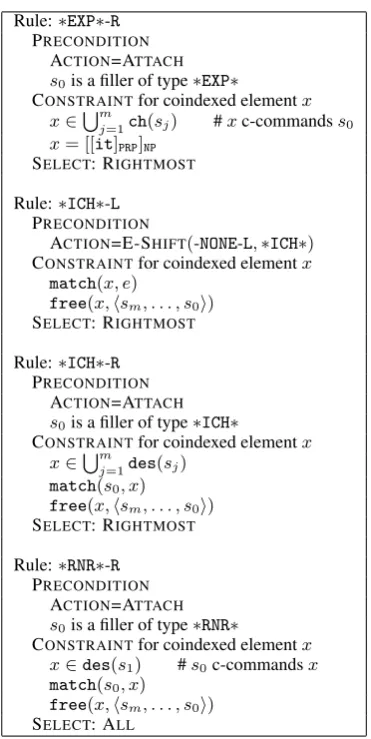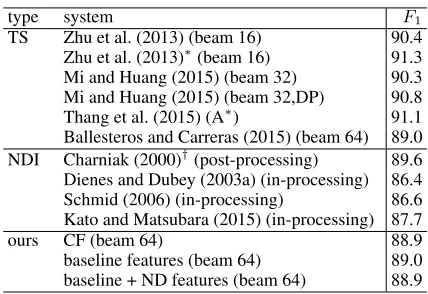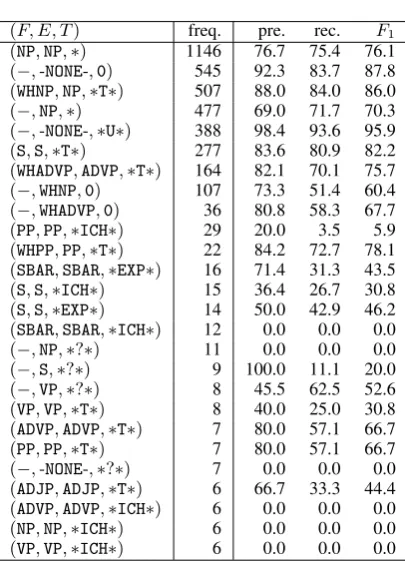Transition-Based Left-Corner Parsing for
Identifying PTB-Style Nonlocal Dependencies
Yoshihide Kato1 and Shigeki Matsubara2
1Information & Communications, Nagoya University 2Graduate School of Information Science, Nagoya University
Furo-cho, Chikusa-ku, Nagoya, 464-8601 Japan
yoshihide@icts.nagoya-u.ac.jp
Abstract
This paper proposes a left-corner parser which can identify nonlocal dependencies. Our parser integrates nonlocal dependency identification into a transition-based sys-tem. We use a structured perceptron which enables our parser to utilize global features captured by nonlocal dependencies. An experimental result demonstrates that our parser achieves a good balance between constituent parsing and nonlocal depen-dency identification.
1 Introduction
Many constituent parsers based on the Penn Tree-bank (Marcus et al., 1993) are available, but most of them do not deal with nonlocal dependen-cies. Nonlocal dependencies represent syntactic phenomenon such as wh-movement, A-movement in passives, topicalization, raising, control, right node raising and so on. Nonlocal dependencies play an important role on semantic interpretation. In the Penn Treebank, a nonlocal dependency is represented as a pair of an empty element and a filler.
Several methods of identifying nonlocal de-pendencies have been proposed so far. These methods can be divided into three approaches: pre-processing approach (Dienes and Dubey, 2003b), in-processing approach (Dienes and Dubey, 2003a; Schmid, 2006; Cai et al., 2011; Kato and Matsubara, 2015) and post-processing approach (Johnson, 2002; Levy and Manning, 2004; Campbell, 2004; Xue and Yang, 2013; Xi-ang et al., 2013; Takeno et al., 2015).1 In
pre-processing approach, a tagger called “trace tag-ger” detects empty elements. The trace tagger uses
1The methods of (Cai et al., 2011; Xue and Yang, 2013; Xiang et al., 2013; Takeno et al., 2015) only detect empty elements.
only surface word information. In-processing ap-proach integrates nonlocal dependency identifica-tion into a parser. The parser uses a probabilis-tic context-free grammar to rank candidate parse trees. Post-processing approach recovers nonlocal dependencies from a parser output which does not include nonlocal dependencies.
The parsing models of the previous methods cannot use global features captured by nonlocal dependencies. Pre- or in-processing approach uses a probabilistic context-free grammar, which makes it difficult to use global features. Post-processing approach performs constituent parsing and nonlocal dependency identification separately. This means that the constituent parser cannot use any kind of information about nonlocal dependen-cies.
This paper proposes a parser which inte-grates nonlocal dependency identification into constituent parsing. Our method adopts an in-processing approach, but does not use a proba-bilistic context-free grammar. Our parser is based on a transition system with structured percep-tron (Collins, 2002), which can easily introduce global features to its parsing model. We adopt a left-corner strategy in order to use the syntac-tic relationc-command, which plays an important role on nonlocal dependency identification. Pre-vious work on transition-based constituent pars-ing adopts a shift-reduce strategy with a tree bina-rization (Sagae and Lavie, 2005; Sagae and Lavie, 2006; Zhang and Clark, 2009; Zhu et al., 2013; Wang and Xue, 2014; Mi and Huang, 2015; Thang et al., 2015; Watanabe and Sumita, 2015), or con-vert constituent trees to “spinal trees”, which are similar to dependency trees (Ballesteros and Car-reras, 2015). These conversions make it difficult for their parsers to capture c-command relations in the parsing process. On the other hand, our parser does not require such kind of conversion.
NP
NN
group NP
SBAR
WHNP-1
WDT
that
S
NP-SBJ-2
-NONE-*T*-1
VP
VBD S
NP-SBJ
-NONE-*-2 VP managed
to traduce its own charter ... DT
the NNP
[image:2.595.80.282.65.204.2]U.N.
Figure 1: A parse tree in the Penn Treebank.
Our contribution can be summarized as follows: 1. We introduce empty element detection into transition-based left-corner constituent pars-ing.
2. We extend c-command relation to deal with nodes inparse tree stackin the transition sys-tem, and develop heuristic rules which coin-dex empty elements with their fillers on the basis of the extended version of c-command. 3. We introduce new features about nonlocal
de-pendency to our parsing model.
This paper is organized as follows: Section 2 explains how to represent nonlocal dependencies in the Penn Treebank. Section 3 describes our transition-based left-corner parser. Section 4 in-troduces nonlocal dependency identification into our parser. Section 5 describes structured percep-tron and features. Section 6 reports an experi-mental result, which demonstrated that our parser achieved a good balance between constituent pars-ing and nonlocal dependency identification. Sec-tion 7 concludes this paper.
2 Nonlocal Dependency
This section describes nonlocal dependencies in the Penn Treebank (Marcus et al., 1993). A nonlo-cal dependency is represented as a pair of anempty element and a filler. Figure 1 shows an exam-ple of (partial) parse tree in the Penn Treebank. The parse tree includes several nonlocal depen-dencies. The nodes labeled with -NONE- are empty elements. The terminal symbols such as ∗ and ∗T∗represent the type of nonlocal dependency:∗ represents an unexpressed subject of to-infinitive. ∗T∗represents a trace of wh-movement. When a
terminal symbol of empty element is indexed, its filler exists in the parse tree. The filler has the same number. For example,∗T∗-1means that the node WHNP-1 is the corresponding filler. Table 1 gives a brief description of empty elements quoted from the annotation guideline (Bies et al., 1995). For more details, see the guideline.
3 Transition-Based Left-Corner Parsing
This section describes our transition-based left-corner parser.
As with previous work (Sagae and Lavie, 2005; Sagae and Lavie, 2006; Zhang and Clark, 2009; Zhu et al., 2013; Wang and Xue, 2014; Mi and Huang, 2015; Thang et al., 2015; Watanabe and Sumita, 2015), our transition-based parsing sys-tem consists of a set of parser states and a finite set of transition actions, each of which maps a state into a new one. A parser state consists of a stack of parse tree nodes and a buffer of input words. A state is represented as a tuple(σ, i), whereσis the stack andiis the next input word position in the buffer. The initial state is(⟨⟩,0). The final states are in the form of(⟨[· · ·]TOP⟩, n), whereTOP is a special symbol for the root of the parse tree andn is the length of the input sentence. The transition actions for our parser are as follows:
• SHIFT(X): pop up the first word from the buffer, assign a POS tagX to the word and push it onto the stack.
The SHIFTaction assigns a POS tag to the shifted word to perform POS tagging and constituent parsing simultaneously. This is in the same way as Wang and Xue (2014).
• LEFTCORNER-{H/∅}(X): pop up the first node from the stack, attach a new node la-beled with X to the node as the parent and push it back onto the stack. H and∅indicate whether or not the popped node is the head child of the new node.
• ATTACH-{H/∅}: pop up the top two nodes from the stack, attach the first one to the sec-ond one as the rightmost child and push it back onto the stack. H and∅indicate whether or not the first node is the head child of the second one.
type description n-posi
∗ arbitrary PRO, controlled PRO and trace of A-movement L,R,−
∗EXP∗ expletive (extraposition) R
∗ICH∗ interpret constituent here (discontinuous dependency) L,R
∗RNR∗ right node raising R
∗T∗ trace of A′-movement A,L
0 null complementizer −
∗U∗ unit −
[image:3.595.151.448.60.169.2]∗?∗ placeholder for ellipsed material − ∗NOT∗ anti-placeholder in template gapping −
Table 1: Empty elements in the Penn Treebank.
SHIFT(X) (⟨sm, . . . , s0⟩, i)⇒(⟨sm, . . . , s0,[wi]X⟩, i+ 1) LEFTCORNER-{H/∅}(X) (⟨sm, . . . , s1, s0⟩, i)⇒(⟨sm, . . . , s1,[s0]X⟩, i)
ATTACH-{H/∅} (⟨sm, . . . , s2,[σ1]X, s0⟩, i)⇒(⟨sm, . . . , s2,[σ1s0]X⟩, i)
Figure 2: Transition actions for left-corner parsing.
difference between ATTACH and REDUCE. The REDUCE action cannot deal with any node with more than two children. For this reason, the previ-ous work converts parse trees into binarized ones. The conversion makes it difficult to capture the hierarchical structure of the parse trees. On the other hand, ATTACHaction can handle more than two children. Therefore, our parser does not re-quire such kind of tree binarization. These tran-sition actions are similar to the ones described in (Henderson, 2003), although his parser uses right-binarized trees and does not identify head-children. Figure 2 summarizes the transition ac-tions for our parser.
To guarantee that every non-terminal node has exactly one head child, our parser uses the follow-ing constraints:
• LEFTCORNERand ATTACHare not allowed whens0has no head child.
• ATTACH-H is not allowed whens1has a head
child.
Table 2 shows the first several transition actions which derive the parse tree shown in Figure 1. Head children are indicated by the superscript∗.
Previous transition-based constituent parsing does not handle nonlocal dependencies. One ex-ception is the work of Maier (2015), who pro-poses shift-reduce constituent parsing with swap action. The parser can handle nonlocal dependen-cies represented as discontinuous constituents. In this framework, discontinuities are directly anno-tated by allowing crossing branches. Since the notation style is quite different from the PTB an-notation, the parser is not suitable for identifying
the PTB style nonlocal dependencies.2
4 Nonlocal Dependency Identification
Nonlocal dependency identification consists of two subtasks:
• empty element detection.
• empty element resolution, which coindexes empty elements with their fillers.
Our parser can insert empty elements at an arbi-trary position to realize empty element detection. This is in a similar manner as the in-processing approach. Our method coindexes empty elements with their fillers using simple heuristic rules, which are developed for our transition system.
4.1 Empty Element Detection
We introduce the following action to deal with empty elements:
E-SHIFT(E, t) :
(⟨sm, . . . , s0⟩, i)⇒(⟨sm, . . . , s0,[t]E⟩, i)
This action simply inserts an empty element at an arbitrary position and pops up no element from the buffer (see the transition from #11 to #12 shown in Table 2 as an example).
4.2 Annotations
For empty element resolution, we augment the Penn Treebank. For nonlocal dependency types
action # state (initial state) 1 (⟨⟩,0)
SHIFT(DT) 2 (⟨[the]DT⟩,1)
LEFTCORNER-∅(NP) 3 (⟨[[the]DT]NP⟩,1)
SHIFT(NNP) 4 (⟨[[the]DT]NP,[U.N.]NNP⟩,2)
ATTACH-∅ 5 (⟨[[the]DT[U.N.]NNP]NP⟩,2)
SHIFT(NN) 6 (⟨[[the]DT[U.N.]NNP]NP,[group]NN⟩,3)
ATTACH-H 7 (⟨[[the]DT[U.N.]NNP[group]NN∗]NP⟩,3)
LEFTCORNER-H(NP) 8 (⟨[[[the]DT[U.N.]NNP[group]NN∗]NP∗]NP⟩,3)
SHIFT(WDT) 9 (⟨[[[the]DT[U.N.]NNP[group]NN∗]NP∗]NP,[that]WDT⟩,4)
LEFTCORNER-H(WHNP-∗T∗-NP-L) 10 (⟨[[[the]DT[U.N.]NNP[group]NN∗]NP∗]NP,[[that]WDT∗]WHNP-∗T∗-NP-L⟩,4)
LEFTCORNER-H(SBAR) 11 (⟨[[[the]DT[U.N.]NNP[group]NN∗]NP∗]NP,[[[that]WDT∗]WHNP-∗T∗-NP-L∗]SBAR⟩,4)
[image:4.595.79.527.61.196.2]E-SHIFT(-NONE-NP-L,∗T∗) 12 (⟨[[[the]DT[U.N.]NNP[group]NN∗]NP∗]NP,[[[that]WDT∗]WHNP-∗T∗-NP-L∗]SBAR,[∗T∗]-NONE-NP-L⟩,4)
Table 2: An example of transition action sequence.
∗EXP∗,∗ICH∗,∗RNR∗and∗T∗, we assign the fol-lowing information to each filler and each empty element:
• The nonlocal dependency type (only for filler).
• The nonlocal dependency category, which is defined as the category of the parent of the empty element.
• The relative position of the filler, which take a value from {A,L,R}. “A” means that the filler is an ancestor of the empty element. “L” (“R”) means that the filler occurs to the left (right) of the empty element. Table 1 sum-marizes which value each empty element can take.
The information is utilized for coindexing empty elements with fillers. Below, we writen-type(x),
n-cat(x)andn-posi(x)for the information of a nodex, respectively.
If an empty element of type∗is indexed, we an-notate the empty element in the same way.3
Fur-thermore, we assign a tagOBJCTRLto every empty element if its coindexed constituent does not have the function tag SBJ.4 This enables our parser
to distinguish between subject control and object control.
Figure 3 shows the augmented version of the parse tree of Figure 1.
4.3 Empty Element Resolution
Nonlocal dependency annotation in the Penn Tree-bank is based on Chomsky’s GB-theory (Chom-sky, 1981). This means that there exist c-command relations between empty elements and
3We omit its nonlocal dependency category, since it is al-waysNP.
4In the Penn Treebank, every subject has the tagSBJ.
NP
NN
group NP
SBAR
WHNP-*T*-NP-L
WDT
that
S
NP-SBJ
-NONE-NP-L
*T*
VP
VBD S
NP-SBJ
-NONE-L
* managed DT
the NNP
U.N.
VP
[image:4.595.311.524.241.376.2]to traduce its own charter ...
Figure 3: An augmented parse tree.
fillers in many cases. For example, all the empty elements in Figure 1 are c-commanded by their fillers. Our method coindexes empty elements with their fillers by simple heuristic rules based on the c-command relation.
4.3.1 C-command Relation
Here, we define c-command relation in a parse tree as follows:
• A nodex c-commandsa node y if and only if there exists some node z such that z is a sibling ofx(x ̸=z)andyis a descendant of z.
NP2
NP5 SBAR8
WHNP-*T*-NP-L7
WDT6
that
S11
NP-SBJ10
-NONE-NP-L9
*T*
VP13
VBD12
-NONE-L14
*
managed NNS3
U.N. DT1
the
s
0
NN4
group
s
1
s
2
s
[image:5.595.325.508.56.328.2]3 e
Figure 4: An example of resolution of[∗]-NONE-L.
• LetS = (⟨sm, . . . , s0⟩, i) be a parser state.
Letybe a descendant ofsj andx be a child
of some nodesk(j < k ≤ m), respectively.
Then,xc-commandsy in any final state de-rived from the stateS.
Below, we say that x c-commandsy, even when the nodesxandysatisfy the above statement.
As an example, let us consider the state shown in Figure 4. The subscripts of nodes indicate the order in which the nodes are instantiated. The nodes in dotted box c-command the shifted node -NONE-L14 in terms of the above statement. In
the parse tree shown in Figure 3, which is de-rived from this state, these nodes c-commands -NONE-L14by the original definition.
4.3.2 Resolution Rules
Our parser coindexes an empty element with its filler, when E-SHIFTor ATTACHis executed. E-SHIFT action coindexes the shifted empty ele-ment e such that n-posi(e) = L with its filler. ATTACH action coindexes the attached filler s0 such that n-posi(s0) = R with its
correspond-ing empty element. Resolution rules consist of three parts: PRECONDITION, CONSTRAINT and SELECT. Empty element resolution rule is applied to a state when the state satisfies PRECONDITION of the rule. CONSTRAINT represents the condi-tions which coindexed element must satisfy. SE -LECTcan take two values ALLand RIGHTMOST. When there exist several elements satisfying the CONSTRAINT, SELECT determines how to select coindexed elements. ALL means that all the ele-ments satisfying the CONSTRAINTare coindexed. RIGHTMOST selects the rightmost element satis-fying the CONSTRAINT.
The most frequent type of nonlocal dependency in the Penn Treebank is∗. Figure 5 shows the res-olution rules for type ∗. Here, ch(s) designates the set of the children of s. sbj(x) means that x has a function tag SBJ. par(x) designates the parent ofx.cat(x)represents the constituent
cat-Rule:∗-L PRECONDITION
ACTION=E-SHIFT(-NONE-L,∗)
CONSTRAINTfor coindexed elementx x∈∪mj=0ch(sj) #xc-commandse
sbj(x)
SELECT: RIGHTMOST
Rule:∗-L-OBJCTRL PRECONDITION
ACTION=E-SHIFT(-NONE-L-OBJCTRL,∗)
CONSTRAINTfor coindexed elementx x∈∪mj=0ch(sj) #xc-commandse
cat(x) =NP∨cat(x) =PP cat(par(x)) =VP
SELECT: RIGHTMOST
Rule:∗-R PRECONDITION
ACTION=ATTACH
sbj(s0)
CONSTRAINTfor coindexed elementx x∈des(s1) #s0c-commandsx
x= [∗]-NONE-R
free(x,⟨sm, . . . , s0⟩)
SELECT: ALL
Figure 5: Resolution rules for type∗.
egory ofx. des(s)designates the set of the proper descendants ofs. free(x, σ)means that xis not coindexed with a node included inσ.
The first rule ∗-L is applied to a state when E-SHIFT action inserts an empty element e =
[∗]-NONE-L. This rule seeks a subject which
c-commands the shifted empty element. The first constraint means that the nodexc-commands the empty element e, since the resulting state of E-SHIFT action is (⟨sm, . . . , s0, e⟩, i), and x and e satisfy the statement in section 4.3.1. For exam-ple, the node NP-SBJ10 shown in Figure 4
satis-fies these constraints (the dotted box represents the first constraint). Therefore, our parser coindexes
NP-SBJ10with -NONE-L14.
The second rule ∗-L-OBJCTRL seeks an object instead of a subject. The second and third con-straints identify whether or notxis an argument. Ifxis a prepositional phrase, our parser coindexes ewithx’s child noun phrase instead ofxitself, in order to keep the PTB-style annotation.
The third rule∗-Ris for null subject of particip-ial clause. Figure 6 shows an example of applying the rule∗-Rto a state. This rule is applied to a state when the transition action is ATTACH ands0 is a subject. By definition, the first constraint means thats0 c-commandsx.
[image:5.595.78.292.63.134.2]ap-SBAR7
WHNP-*T*-NP-L6
WP5
which
S11
NP-SBJ9 VP13
VBZ12 NP15
-NONE-NP-L14
*T* takes
NNS10
bank DT8
the
VP-CRD16
CC17
or
VP19
VBZ18
plans
-NONE-NP-L20
*T*
remove coordinate structure
SBAR7
WHNP-*T*-NP-L6
WP5
which
S11
NP-SBJ9
NNS10
bank DT8
the
VP19
VBZ18
plans
-NONE-NP-L20
*T*
s0 s1
s2
[image:6.595.162.439.63.274.2]s3 e
Figure 9: An example of resolution of[∗T∗]-NONE-NP-Lin the case where the stack has coordinate structure.
S3
NP-SBJ2
-NONE-R1
* VP4
Considered as a whole
S5
,6
,
NP-SBJ7
s 0 s
1
des(s 1)
S3
NP-SBJ2
-NONE-R1
* VP4
S5
,6
, NP-SBJ7
Attach des(s
1)
Considered as a whole
[image:6.595.77.287.330.434.2]s 1
Figure 6: An example of resolution of[∗]-NONE-R.
Rule:∗T∗-L PRECONDITION
ACTION=E-SHIFT(-NONE-L,∗T∗)
CONSTRAINTfor coindexed elementx
#xc-commandse
x∈∪s∈removeCRD(⟨sm,...,s0⟩)ch(s)
match(x, e)
free(x,removeCRD(⟨sm, . . . , s0⟩))
[image:6.595.99.264.473.570.2]SELECT: RIGHTMOST
Figure 7: Resolution rule for type∗T∗.
plied to a state when E-SHIFT action inserts an empty element of type ∗T∗. Here, match(x, y)
checks the consistency between x andy, that is,
match(x, y) holds if and only if n-type(x) = n-type(y),n-cat(x) = n-cat(y), n-posi(x) = n-posi(y), cat(x) ̸= -NONE- and cat(y) =
-NONE-. removeCRD(⟨sm, . . . , s0⟩) is a stack
which is obtained by removing sj(0 ≤ j ≤ m)
which is annotated with a tag CRD.5 The tagCRD 5We assign a tagCRDto a node, when it matches the pat-tern[· · ·[· · ·]X· · ·[· · ·](CC|CONJP|,|:)· · ·[· · ·]X· · ·]X.
SBAR7
WHNP-*T*-NP-L6
WP5
which
S11
NP-SBJ9
VP13
VBZ12
-NONE-NP-L14
*T*
takes NNS10
bank DT8
the
s
0
s
1
s
2 e
Figure 8: An example of resolution of
[∗T∗]-NONE-NP-L.
means that the node is coordinate structure. In general, each filler of type ∗T∗ is coindexed with only one empty element. However, a filler of type ∗T∗can be coindexed with several empty elements if the empty elements are included in coordinate structure. This is the reason why our parser uses
removeCRD. Figure 8 and 9 give examples of res-olution for type∗T∗.
The empty elements [∗T∗]-NONE-A are handled
by an exceptional process. When ATTACH ac-tion is applied to a state(⟨sm, . . . , s0⟩, i)such that
cat(s0) = PRN, the parser coindexes the empty
elementx = [∗T∗]-NONE-A included ins0 with s1.
More precisely, the coindexation is executed if the following conditions hold:
• x∈des(s0)
• match(s1, x)
• free(x,⟨sm, . . . , s0⟩)
simi-Rule:∗EXP∗-R PRECONDITION
ACTION=ATTACH s0is a filler of type∗EXP∗
CONSTRAINTfor coindexed elementx x∈∪mj=1ch(sj) #xc-commandss0
x= [[it]PRP]NP
SELECT: RIGHTMOST
Rule:∗ICH∗-L PRECONDITION
ACTION=E-SHIFT(-NONE-L,∗ICH∗)
CONSTRAINTfor coindexed elementx
match(x, e)
free(x,⟨sm, . . . , s0⟩)
SELECT: RIGHTMOST
Rule:∗ICH∗-R PRECONDITION
ACTION=ATTACH s0is a filler of type∗ICH∗
CONSTRAINTfor coindexed elementx x∈∪mj=1des(sj)
match(s0, x)
free(x,⟨sm, . . . , s0⟩)
SELECT: RIGHTMOST
Rule:∗RNR∗-R PRECONDITION
ACTION=ATTACH s0is a filler of type∗RNR∗
CONSTRAINTfor coindexed elementx x∈des(s1) #s0c-commandsx
match(s0, x)
free(x,⟨sm, . . . , s0⟩)
[image:7.595.89.275.57.427.2]SELECT: ALL
Figure 10: Resolution rule for ∗EXP∗,∗ICH∗and ∗RNR∗.
lar idea to design the resolution rules. Figure 10 shows the resolution rules.
These heuristic resolution rules are similar to the previous work (Campbell, 2004; Kato and Matsubara, 2015), which also utilizes c-command relation. An important difference is that we design heuristic rules not for fully-connected parse tree but for stack of parse trees derived by left-corner parsing. That is, the extend version of c-command relation plays an important role on our heuristic rules.
5 Parsing Strategy
We use a beam-search decoding with the struc-tured perceptron (Collins, 2002). A transition ac-tionafor a stateShas a score defined as follows:
score(S, a) =w·f(S, a)
where f(S, a) is the feature vector for the state-action pair(S, a), andwis a weight vector. The
input:sentencew1· · ·wn, beam sizek
H ← {S0} #S0is the initial state forw1· · ·w0 repeatNtimesdo
C← {}
for eachS ∈Hdo
for eachpossible actionado S′←applyatoS pushS′toC
H←kbest states ofC returnbest final state inC
Figure 11: Beam-search parsing.
score of a stateS′ which is obtained by applying
an actionato a stateSis defined as follows: score(S′) =score(S) +score(S, a)
For the initial stateS0,score(S0) = 0.
We learn the weight vectorwby max-violation method (Huang et al., 2012) and average the weight vector to avoid overfitting the training data (Collins, 2002).
In our method, action sequences for the same sentence have different number of actions because of E-SHIFT action. To absorb the difference, we use an IDLEaction, which are proposed in (Zhu et al., 2013):
IDLE: (⟨[· · ·]TOP⟩, n)⇒(⟨[· · ·]TOP⟩, n) Figure 11 shows details of our beam-search pars-ing. The algorithm is the same as the previous transition-based parsing with structured percep-tron. One point to be noted here is how to de-termine the maximum length of action sequence (= N) which the parser allows. Since it is im-possible to know in advance how many empty el-ements a parse tree has, we need to set this param-eter as a sufficiently larger value.
5.1 Features
A feature is defined as the concatenation of a tran-sition action and a state feature which is extracted using a feature template. Table 3 shows our base-line feature templates. The feature templates are similar to the ones of (Zhang and Clark, 2009), which are standardly used as baseline templates for transition-based constituent parsing. Here, bi
and si stand for the i-th element of buffer and
[image:7.595.320.512.61.163.2]type feature templates unigram s0.c◦s0.t,s0.c◦s0.w,
s0.l.c◦s0.l.w,s0.r.c◦s0.r.w,s0.h.c◦s0.h.w,
s1.c◦s1.t,s1.c◦s1.w,
s1.l.c◦s1.l.w,s1.r.c◦s1.r.w,s1.h.c◦s1.h.w,
s2.c◦s2.t,s2.c◦s2.w,s3.c◦s3.t,s3.c◦s3.w,
b0.i,b0.w,b1.i,b1.w,b2.i,b2.w,b3.i,b3.w bigram s1.w◦s0.w,s1.c◦s0.w,s1.w◦s0.c,s1.w◦s0.w,
s0.c◦b0.i,s0.c◦b0.w,s0.w◦b0.i,s0.w◦b0.w,
s1.c◦b0.i,s1.c◦b0.w,s1.w◦b0.i,s1.w◦b0.w,
b0.i◦b1.i,b0.w◦b1.i,b0.i◦b1.w,b0.w◦b1.w trigram s2.c◦s1.c◦s0.c,s2.c◦s1.c◦s0.w,
s2.c◦s1.w◦s0.c,s2.w◦s1.c◦s0.c,
s1.c◦s0.c◦b0.i,s1.w◦s0.c◦b0.i,
[image:8.595.309.523.59.206.2]s1.c◦s0.w◦b0.i,s1.w◦s0.w◦b0.i
Table 3: Baseline feature templates.
feature templates
s0.n0.c,s0.n1.c,s1.n0.c,s1.n1.c,
rest2.n0.c,rest2.n1.c
Table 4: Nonlocal dependency feature templates.
does not yet have a head child, the head-based atomic features are set to a special symbol nil. To extract the features, we need to identify head children in parse trees. We use the head rules de-scribed in (Surdeanu et al., 2008).
In addition to these features, we introduce a new feature which is related to empty element resolu-tion. When a transition action invokes empty ele-ment resolution described in section 4.3.2, we use as a feature, whether or not the procedure coin-dexes empty elements with a filler. Such a feature is difficult for a PCFG to capture. This feature en-ables our parsing model to learn the resolution rule preferences implicitly, while the training process is performed only with oracle action sequences.
In addition, we use features about free empty elements and fillers. Table 4 summarizes such fea-ture templates. Here,x.nistands for thei-th
right-most free element included inx, andresti stands
for the stack⟨sm, . . . , si⟩. 6 Experiment
We conducted an experiment to evaluate the per-formance of our parser using the Penn Treebank. We used a standard setting, that is, section 02-21 is for the training data, section 22 is for the devel-opment data and section 23 is for the test data.
In training, we set the beam size k to 16 to achieve a good efficiency. We determined the op-timal iteration number of perceptron training, and the beam size (kwas set to 16, 32 and 64) for de-coding on the development data. The maximum
type system F1
TS Zhu et al. (2013) (beam 16) 90.4 Zhu et al. (2013)∗(beam 16) 91.3 Mi and Huang (2015) (beam 32) 90.3 Mi and Huang (2015) (beam 32,DP) 90.8 Thang et al. (2015) (A∗) 91.1 Ballesteros and Carreras (2015) (beam 64) 89.0 NDI Charniak (2000)†(post-processing) 89.6 Dienes and Dubey (2003a) (in-processing) 86.4 Schmid (2006) (in-processing) 86.6 Kato and Matsubara (2015) (in-processing) 87.7
ours CF (beam 64) 88.9
baseline features (beam 64) 89.0 baseline + ND features (beam 64) 88.9 TS: transition-based parsers with structured perceptron. NDI: parsers with nonlocal dependency identification. DP: Dynamic Programming.
Zhu et al. (2013)∗uses additional language resources. †Johnson (2002) and Campbell (2004) used the output of Charniak’s parser.
Table 5: Comparison for constituent parsing.
length of action sequences (= N) was set to7n, wherenis the length of input sentence. This max-imum length was determined to deal with the sen-tences in the training data.
Table 5 presents the constituent parsing perfor-mances of our system and previous systems. We used the labeled bracketing metric PARSEVAL (Black et al., 1991). Here, “CF” is the parser which was learned from the training data where nonlocal dependencies are removed. This result demonstrates that our nonlocal dependency iden-tification does not have a bad influence on con-stituent parsing. From the viewpoint of transition-based constituent parsing, our left-corner parser is somewhat inferior to other perceptron-based shift-reduce parsers. On the other hand, our parser out-performs the parsers which identify nonlocal de-pendency based on in-processing approach.
We use the metric proposed by Johnson (2002) to evaluate the accuracy of nonlocal dependency identification. Johnson’s metric represents a non-local dependency as a tuple which consists of the type of the empty element, the category of the empty element, the position of the empty ele-ment, the category of the filler and the position of the filler. For example, the nonlocal depen-dency of the type ∗T∗ in Figure 1 is represented as(∗T∗,NP,[4,4],WHNP,[3,4]). The precision and the recall are measured using these tuples. For more details, see (Johnson, 2002).
Unindexed empty elements are excluded
rec. pre. F1 rec. pre. F1
Johnson (2002) (post-processing) 63 73 68 − − −
D & D (2003a) (pre-processing) 66.0 80.5 72.6 − − − D & D (2003b) (in-processing) 68.7 81.5 74.6 − − − Campbell (2004) (post-processing) 75.1 78.3 76.7 − − − Schmid (2006) (in-processing) − − − 73.5 81.7 77.4 K&M (2015) (in-processing) 75.6 80.6 78.0 73.6 80.3 76.8
baseline features 70.4 79.7 74.8 65.4 81.1 72.4
[image:9.595.129.467.61.174.2]+ ND features 75.5 81.4 78.4 73.8 79.8 76.7
Table 6: Comparison for nonlocal dependency identification.
achieved the state-of-the-art performance of non-local dependency identification, while it was in-ferior in terms of constituent parsing accuracy. Our nonlocal dependency identification is com-petitive with previous in-processing approach, and its accuracy of constituent parsing is higher than previous in-processing approach. As a whole, our parser achieves a good balance between con-stituent parsing and nonlocal dependency identifi-cation. Table 7 summarizes the accuracy of nonlo-cal dependency identification for each type of non-local dependency.
7 Conclusion
This paper proposed a transition-based parser which identifies nonlocal dependencies. Our parser achieves a good balance between con-stituent parsing and nonlocal dependency identi-fication. In the experiment reported in this pa-per, we used simple features which are captured by nonlocal dependencies. In future work, we will develop lexical features which are captured by nonlocal dependencies.
Acknowledgements
This research was partially supported by the Grant-in-Aid for Scientific Research (B) (No.26280082) of JSPS.
References
Miguel Ballesteros and Xavier Carreras. 2015. Transition-based spinal parsing. InProceedings of the Nineteenth Conference on Computational Nat-ural Language Learning, pages 289–299, Beijing, China, July.
Ann Bies, Mark Ferguson, Karen Katz, and Robert MacIntyre. 1995. Bracketing Guidelines for Tree-bank II Style Penn TreeTree-bank Project. University of Pennsylvania.
(F, E, T) freq. pre. rec. F1
(NP,NP,∗) 1146 76.7 75.4 76.1
(−,-NONE-,0) 545 92.3 83.7 87.8
(WHNP,NP,∗T∗) 507 88.0 84.0 86.0
(−,NP,∗) 477 69.0 71.7 70.3
(−,-NONE-,∗U∗) 388 98.4 93.6 95.9
(S,S,∗T∗) 277 83.6 80.9 82.2
(WHADVP,ADVP,∗T∗) 164 82.1 70.1 75.7
(−,WHNP,0) 107 73.3 51.4 60.4
(−,WHADVP,0) 36 80.8 58.3 67.7
(PP,PP,∗ICH∗) 29 20.0 3.5 5.9
(WHPP,PP,∗T∗) 22 84.2 72.7 78.1
(SBAR,SBAR,∗EXP∗) 16 71.4 31.3 43.5
(S,S,∗ICH∗) 15 36.4 26.7 30.8
(S,S,∗EXP∗) 14 50.0 42.9 46.2
(SBAR,SBAR,∗ICH∗) 12 0.0 0.0 0.0
(−,NP,∗?∗) 11 0.0 0.0 0.0
(−,S,∗?∗) 9 100.0 11.1 20.0
(−,VP,∗?∗) 8 45.5 62.5 52.6
(VP,VP,∗T∗) 8 40.0 25.0 30.8
(ADVP,ADVP,∗T∗) 7 80.0 57.1 66.7
(PP,PP,∗T∗) 7 80.0 57.1 66.7
(−,-NONE-,∗?∗) 7 0.0 0.0 0.0
(ADJP,ADJP,∗T∗) 6 66.7 33.3 44.4
(ADVP,ADVP,∗ICH∗) 6 0.0 0.0 0.0
(NP,NP,∗ICH∗) 6 0.0 0.0 0.0
(VP,VP,∗ICH∗) 6 0.0 0.0 0.0
Table 7: Accuracy of nonlocal dependency identi-fication for all types of nonlocal dependency that occurred more than 5 times in section 23 of the Penn Treebank. F,E andT give the category of its filler, the category of its empty element and the type of nonlocal dependency, respectively.
E. Black, S. Abney, D. Flickenger, C. Gdaniec, R. Gr-ishman, P. Harrison, D. Hindle, R. Ingria, F. Jelinek, J. Klavans, M. Liberman, M. Marcus, S. Roukos, B. Santorini, and T. Strzalkowski. 1991. A proce-dure for quantitatively comparing the syntactic cov-erage of English grammars. InProceedings of the 4th DARPA Speech and Natural Language Work-shop, pages 306–311.
[image:9.595.315.518.209.490.2]216, Portland, Oregon, USA, June.
Richard Campbell. 2004. Using linguistic principles to recover empty categories. InProceedings of the 42nd Meeting of the Association for Computational Linguistics (ACL’04), Main Volume, pages 645–652, Barcelona, Spain, July.
Eugene Charniak. 2000. A maximum-entropy-inspired parser. In Proceedings of the 1st North American Chapter of the Association for Computa-tional Linguistics, pages 132–139, April.
Noam Chomsky. 1981. Lectures on government and binding: The Pisa lectures. Walter de Gruyter. Michael Collins. 2002. Discriminative training
meth-ods for hidden markov models: Theory and experi-ments with perceptron algorithms. InProceedings of the 2002 Conference on Empirical Methods in Natural Language Processing, pages 1–8, July.
P´eter Dienes and Amit Dubey. 2003a. Antecedent re-covery: Experiments with a trace tagger. In Michael Collins and Mark Steedman, editors,Proceedings of the 2003 Conference on Empirical Methods in Nat-ural Language Processing, pages 33–40, July.
P´eter Dienes and Amit Dubey. 2003b. Deep syntactic processing by combining shallow methods. In Pro-ceedings of the 41st Annual Meeting of the Associa-tion for ComputaAssocia-tional Linguistics, pages 431–438, Sapporo, Japan, July.
Kilian Evang and Laura Kallmeyer. 2011. Plcfrs pars-ing of english discontinuous constituents. In Pro-ceedings of the 12th International Conference on Parsing Technologies, pages 104–116, Dublin, Ire-land, October.
James Henderson. 2003. Inducing history representa-tions for broad coverage statistical parsing. In Pro-ceedings of the 2003 Human Language Technology Conference of the North American Chapter of the Association for Computational Linguistics, pages 24–31, Edmonton, Canada.
Liang Huang, Suphan Fayong, and Yang Guo. 2012. Structured perceptron with inexact search. In Pro-ceedings of the 2012 Conference of the North Amer-ican Chapter of the Association for Computational Linguistics: Human Language Technologies, pages 142–151, Montr´eal, Canada, June.
Mark Johnson. 2002. A simple pattern-matching al-gorithm for recovering empty nodes and their an-tecedents. InProceedings of 40th Annual Meeting of the Association for Computational Linguistics, pages 136–143, Philadelphia, Pennsylvania, USA, July.
Yoshihide Kato and Shigeki Matsubara. 2015. Iden-tifying nonlocal dependencies in incremental pars-ing. IEICE Transactions on Information and Sys-tems, E98-D(4):994–998.
Roger Levy and Christopher Manning. 2004. Deep dependencies from context-free statistical parsers: Correcting the surface dependency approximation. InProceedings of the 42nd Meeting of the Associa-tion for ComputaAssocia-tional Linguistics (ACL’04), Main Volume, pages 327–334, Barcelona, Spain, July. Wolfgang Maier. 2015. Discontinuous incremental
shift-reduce parsing. InProceedings of the 53rd An-nual Meeting of the Association for Computational Linguistics and the 7th International Joint Confer-ence on Natural Language Processing (Volume 1: Long Papers), pages 1202–1212, Beijing, China, July.
Mitchell P. Marcus, Beatrice Santorini, and Mary Ann Marcinkiewicz. 1993. Building a large annotated corpus of English: the Penn Treebank. Computa-tional Linguistics, 19(2):310–330.
Haitao Mi and Liang Huang. 2015. Shift-reduce con-stituency parsing with dynamic programming and pos tag lattice. InProceedings of the 2015 Confer-ence of the North American Chapter of the Associ-ation for ComputAssoci-ational Linguistics: Human Lan-guage Technologies, pages 1030–1035, Denver, Col-orado, May–June.
Kenji Sagae and Alon Lavie. 2005. A classifier-based parser with linear run-time complexity. In Proceed-ings of the Ninth International Workshop on Pars-ing Technology, pages 125–132, Vancouver, British Columbia, October.
Kenji Sagae and Alon Lavie. 2006. A best-first prob-abilistic shift-reduce parser. In Proceedings of the COLING/ACL 2006 Main Conference Poster Ses-sions, pages 691–698, Sydney, Australia, July. Helmut Schmid. 2006. Trace prediction and
recov-ery with unlexicalized PCFGs and slash features. In Proceedings of the 21st International Conference on Computational Linguistics and 44th Annual Meet-ing of the Association for Computational LMeet-inguis- Linguis-tics, pages 177–184, Sydney, Australia, July. Mihai Surdeanu, Richard Johansson, Adam Meyers,
Llu´ıs M`arquez, and Joakim Nivre. 2008. The conll 2008 shared task on joint parsing of syntactic and se-mantic dependencies. InCoNLL 2008: Proceedings of the Twelfth Conference on Computational Nat-ural Language Learning, pages 159–177, Manch-ester, England, August.
Shunsuke Takeno, Masaaki Nagata, and Kazuhide Ya-mamoto. 2015. Empty category detection using path features and distributed case frames. In Pro-ceedings of the 2015 Conference on Empirical Meth-ods in Natural Language Processing, pages 1335– 1340, Lisbon, Portugal, September.
Conference on Natural Language Processing (Vol-ume 1: Long Papers), pages 1534–1544, Beijing, China, July.
Zhiguo Wang and Nianwen Xue. 2014. Joint POS tag-ging and transition-based constituent parsing in chi-nese with non-local features. InProceedings of the 52nd Annual Meeting of the Association for Compu-tational Linguistics (Volume 1: Long Papers), pages 733–742, Baltimore, Maryland, June.
Taro Watanabe and Eiichiro Sumita. 2015. Transition-based neural constituent parsing. In Proceedings of the 53rd Annual Meeting of the Association for Computational Linguistics and the 7th International Joint Conference on Natural Language Processing (Volume 1: Long Papers), pages 1169–1179, Bei-jing, China, July.
Bing Xiang, Xiaoqiang Luo, and Bowen Zhou. 2013. Enlisting the ghost: Modeling empty categories for machine translation. InProceedings of the 51st An-nual Meeting of the Association for Computational Linguistics (Volume 1: Long Papers), pages 822– 831, Sofia, Bulgaria, August.
Nianwen Xue and Yaqin Yang. 2013. Dependency-based empty category detection via phrase structure trees. In Proceedings of the 2013 Conference of the North American Chapter of the Association for Computational Linguistics: Human Language Tech-nologies, pages 1051–1060, Atlanta, Georgia, June. Yue Zhang and Stephen Clark. 2009. Transition-based parsing of the chinese treebank using a global discriminative model. InProceedings of the 11th International Conference on Parsing Technologies (IWPT’09), pages 162–171, Paris, France, October. Muhua Zhu, Yue Zhang, Wenliang Chen, Min Zhang,
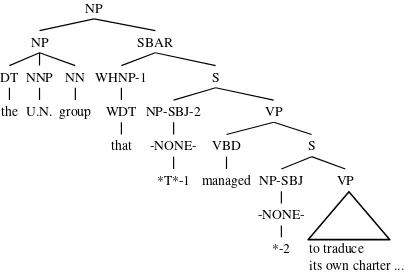
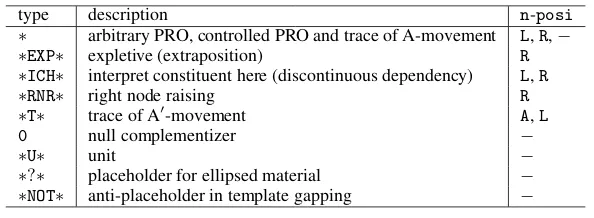

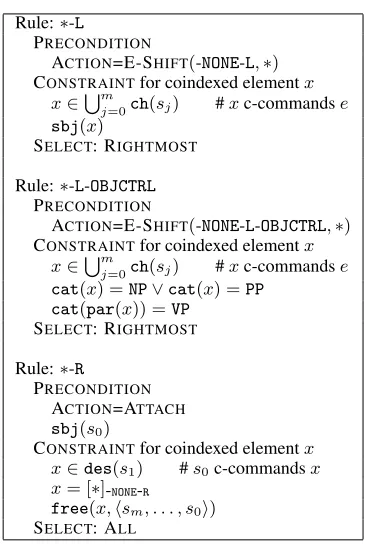
![Figure 9: An example of resolution of [ ∗T]∗ -N O N EN P -L - in the case where the stack has coordinate structure.](https://thumb-us.123doks.com/thumbv2/123dok_us/189100.517818/6.595.162.439.63.274/figure-example-resolution-en-case-stack-coordinate-structure.webp)
